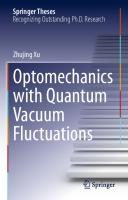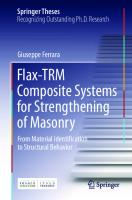Fracture Analysis of Layered Beams With an Elastically Coupled Behavior and Hygrothermal Stresses: Application to Metal-to-Composite Adhesive Joints (Springer Theses) 9783031176203, 9783031176210, 3031176200
This book presents an analytical framework for calculating the fracture toughness of generally layered beam structures w
129 11 7MB
English Pages 298 [286]
Table of contents :
Supervisor’s Foreword
Preface
Parts of this thesis have been published in the following articles:
Acknowledgments
Contents
Nomenclature
Latin Symbols
Greek Symbols
Abbreviations and Acronyms
Subscripts, Superscripts, and Conventions
Other
1 Introduction
1.1 Background and Motivation
1.1.1 General Background
1.1.2 Motivation
1.2 General Aim and Specific Objectives of the Book
1.2.1 General Aim of the Thesis
1.2.2 Specific Objectives of the Book
1.2.3 The Book at a Glance
1.3 Organization and Structure of the Book
1.3.1 Organization of the Book
1.3.2 Structure of the Book
1.4 Contribution of the Thesis
1.5 Basic Concepts and Definitions
1.5.1 Layered, Generally Layered, Multilayered, Laminated
1.5.2 Crack, Delamination, and Disbonding
1.5.3 Definitions for Beams
1.5.4 Data Reduction Scheme (DRS)
References
2 The Effect of Residual Hygrothermal Stresses on the Energy Release Rate and Mode Mixity of Interfacial Cracks in Beams with Bending–Extension Coupling
2.1 Introduction
2.1.1 State of the Art
2.1.2 Present Work
2.2 Problem Description and Analysis Approach
2.2.1 Definition of the Scientific Problem
2.2.2 The Proposed Analytical Model
2.3 Mathematical Formulation of the Problem
2.3.1 Kinematic Assumptions
2.3.2 Constitutive Laws
2.3.3 Conditions of Static Equilibrium
2.3.4 Conditions of Displacement Continuity
2.4 Solution to the Problem
2.4.1 Derivation of the Governing Equation
2.4.2 Solution to the Governing Equation
2.4.3 Internal Forces and Moments
2.4.4 Crack-Tip Forces
2.4.5 Energy Release Rate (ERR) and Mode Mixity (MM)
2.5 Extraction of Closed-Form Equations
2.5.1 Reduction to Typical Test Configurations
2.5.2 Effect of Contact Between the Two Sublaminates
2.5.3 Reduction to Previous Equations in the Literature
2.6 Validation Through Finite Element Analysis (FEA)
2.6.1 Application: A Typical Glass Aluminum Reinforced Epoxy (GLARE)
2.6.2 Finite Element Analyses (FEAs)
2.7 Results
2.7.1 Example 1: Double Cantilever Beam (DCB) Test
2.7.2 Example 2: End-Notched Flexure (ENF) Test
2.8 Discussion
2.9 Conclusions
References
3 Fracture Toughness of Metal-to-Composite Adhesive Joints with Bending–Extension Coupling and Residual Thermal Stresses
3.1 Introduction
3.1.1 State of the Art
3.1.2 Present Work
3.2 Description of the Technical and Scientific Problem
3.2.1 The Metal-to-Composite Adhesive Joint Under Consideration
3.2.2 Challenges in the Design and Data Reduction of Fracture Tests for Dissimilar Adhesive Joints
3.3 Design and Data Reduction of Fracture Tests
3.3.1 Design of the Fracture Toughness Tests
3.3.2 Data Reduction Approach
3.4 Experimental Methods
3.4.1 Materials and Geometry
3.4.2 Fracture Toughness Experiments
3.5 Finite Element Analyses (FEAs)
3.5.1 Two-Dimensional (2D) Finite Element Analyses (FEAs)
3.5.2 Three-Dimensional (3D) Finite Element Analyses (FEAs)
3.5.3 Cohesive Zone Modeling (CZM)
3.6 Results
3.6.1 The Effect of Residual Thermal Stresses (RTS) on the Total Energy Release Rate (ERR) and Mode Mixity (MM)
3.6.2 Crack Propagation Behavior
3.6.3 Data Reduction Using Various Analytical Expressions
3.7 Discussion
3.8 Conclusions
References
4 Interfacial Fracture Toughness of a Titanium-to-CFRP Adhesive Joint
4.1 Introduction
4.1.1 State of the Art
4.1.2 Present Work
4.2 The Titanium-to-CFRP Joint Under Consideration
4.2.1 Configuration
4.2.2 Materials
4.2.3 The Proposed Manufacturing Options (MOs)
4.3 Experimentation
4.3.1 Mechanical Experiments
4.3.2 Fractographic Investigation
4.3.3 Experimental Data Reduction
4.4 Results
4.4.1 Double Cantilever Beam (DCB) Experiments
4.4.2 End-Notched Flexure (ENF) Experiments
4.5 Discussion
4.6 Conclusions
References
5 Energy Release Rate and Mode Partitioning of Moment-Loaded Fracture Tests on Layered Beams with Bending–Extension Coupling and Hygrothermal Stresses
5.1 Introduction
5.1.1 State of the Art
5.1.2 Present Work
5.2 Existing Analytical Expressions
5.3 The Proposed Data Reduction Scheme (DRS)
5.3.1 Problem Description and Approach of the Analysis
5.3.2 Calculation of the Crack-Tip Forces
5.3.3 Calculation of the Energy Release Rate (ERR) and Mode Mixity (MM)
5.3.4 Special Cases and Refinement to Pre-existing Equations
5.4 Numerical Validation
5.4.1 Case Studies
5.4.2 Finite Element Analysis (FEA)
5.5 Experimental Methods
5.5.1 Double Cantilever Beam Test Fixture with Uneven Bending Moments (DCB-UBM Test Fixture)
5.5.2 The Titanium-to-CFRP Adhesive Joint
5.5.3 Execution of the Experiments
5.6 Results
5.6.1 Validation of the Data Reduction Scheme (DRS)
5.6.2 Application in Actual Experiments
5.7 Discussion
5.8 Conclusions
References
6 Closed-Form Solution for Interfacially Cracked Layered Beams with Bending–Extension Coupling and Hygrothermal Stresses
6.1 Introduction
6.1.1 State of the Art
6.1.2 Present Work
6.2 Problem Description and Assumptions
6.2.1 Motivation
6.2.2 Definition of the Problem
6.2.3 Assumptions
6.3 Mathematical Formulation of the Problem
6.3.1 Kinematic Assumptions
6.3.2 Constitutive Laws
6.3.3 Conditions of Static Equilibrium
6.3.4 Conditions of Displacement Continuity
6.3.5 Boundary Conditions
6.4 Extraction of Closed-Form Expressions
6.4.1 Solution Strategy
6.4.2 Solution Along the Uncracked Region
6.4.3 Solution Along the Cracked Region
6.4.4 Complete Solution
6.5 Refinements and a Suggested Improved Solution
6.5.1 Reduction to Unified Test Configurations
6.5.2 Refinement for a Clamped Crack Tip
6.5.3 Refinements for Common Material Systems
6.5.4 The Balanced Case
6.5.5 On Improving the Equations for the Contact Force
6.6 Application
6.6.1 Application Examples
6.6.2 Application Results
6.7 Discussion
6.8 Conclusions
References
7 Conclusion
7.1 General Summary and Conclusions
7.1.1 Literature Review
7.1.2 Derivation and Implementation of a New Analytical Solution
7.1.3 Numerical Validation of the Analytical Model
7.1.4 Interfacial Cracks Inside Layered Materials
7.1.5 Mode-Mixity (MM) Response
7.1.6 The Effect of Residual Thermal Stresses (RTS)
7.1.7 The Titanium-to-CFRP Adhesive Joint
7.1.8 Some Additional Novelty Points
7.2 Strengths of the Proposed Analytical Model and Expressions
7.3 Ongoing Work and Suggestions for Future Work
7.3.1 The Titanium-to-CFRP Adhesive Joint
7.3.2 Contact Problem
7.3.3 Compliance
7.3.4 Determination of the Energy Release Rate (ERR)
7.3.5 Boundary Conditions
7.3.6 Three-Dimensional (3D) Data Reduction Scheme (DRS)
7.3.7 Further Refinement of the Analytical Model
7.3.8 Further Development of the Rigid Joint Model
References
Appendix A First-Order Shear Deformation Theory Considering an Elastically Coupled Behavior and Residual Hygrothermal Stresses
A.1 Stiffness of a Single Layer
A.2 Constitutive Behavior of a Single Layer
A.3 Equivalent Stiffness of a Layered Plate
A.4 Equivalent Stiffness of a Layered Beam
A.4.1 Plane-Strain Conditions
A.4.2 Plane-Stress Conditions
A.4.3 Homogeneous Beam
A.5 Relations Between Stiffness and Compliance Coefficients
References
Appendix B Fracture Mode Partitioning Adopting the Crack Closure Integral Approach
B.1 Crack Closure Integral
B.2 Fracture Mode Partitioning
B.3 Discussion and Concluding Remarks
References
Appendix C Virtual Crack Closure Technique
References
Appendix D Aircraft Application of the Titanium-to-CFRP Adhesive Joint
D.1 The Technological Problem
D.2 Effect of Laminar Flow on the Design of Aerodynamic Surfaces of Aircrafts
D.3 Laminar Flow Design Approaches
D.3.1 The Natural Laminar Flow (NLF) and Laminar Flow Control (LFC) Approaches
D.3.2 The Hybrid Laminar Flow Control (HLFC) Approach
D.4 Hybrid Laminar Flow Control (HLFC) Application of the Present Joint
References
Appendix E Manufacturing the Titanium-to-CFRP Adhesive Joint
E.1 Production of the Joint
E.1.1 Manufacturing Option (MO) 1
E.1.2 Manufacturing Option (MO) 2
E.1.3 Manufacturing Option (MO) 3
E.1.4 Manufacturing Option (MO) 4
E.2 Preparation of the Test Specimens
References
Appendix F Analytical Approaches for Fracture Mode Decoupling
F.1 Bimaterial Joints
F.1.1 Design Criterion 1: Equal Strains
F.1.2 Design Criterion 2: Equal Stiffnesses
F.1.3 Comparison
F.2 More Complex Cases and a Concluding Remark
References
Appendix G Related to the Work in Chap. 6
G.1 Basic Equations of the Analytical Model
G.2 Strain Measures
G.2.1 Uncracked Region
G.2.2 Cracked Region
G.3 Refinement for a Clamped Crack Tip
G.4 Stiffness and Thermal Coefficients of the Sublaminates
Reference
About the Author
Index
Supervisor’s Foreword
Preface
Parts of this thesis have been published in the following articles:
Acknowledgments
Contents
Nomenclature
Latin Symbols
Greek Symbols
Abbreviations and Acronyms
Subscripts, Superscripts, and Conventions
Other
1 Introduction
1.1 Background and Motivation
1.1.1 General Background
1.1.2 Motivation
1.2 General Aim and Specific Objectives of the Book
1.2.1 General Aim of the Thesis
1.2.2 Specific Objectives of the Book
1.2.3 The Book at a Glance
1.3 Organization and Structure of the Book
1.3.1 Organization of the Book
1.3.2 Structure of the Book
1.4 Contribution of the Thesis
1.5 Basic Concepts and Definitions
1.5.1 Layered, Generally Layered, Multilayered, Laminated
1.5.2 Crack, Delamination, and Disbonding
1.5.3 Definitions for Beams
1.5.4 Data Reduction Scheme (DRS)
References
2 The Effect of Residual Hygrothermal Stresses on the Energy Release Rate and Mode Mixity of Interfacial Cracks in Beams with Bending–Extension Coupling
2.1 Introduction
2.1.1 State of the Art
2.1.2 Present Work
2.2 Problem Description and Analysis Approach
2.2.1 Definition of the Scientific Problem
2.2.2 The Proposed Analytical Model
2.3 Mathematical Formulation of the Problem
2.3.1 Kinematic Assumptions
2.3.2 Constitutive Laws
2.3.3 Conditions of Static Equilibrium
2.3.4 Conditions of Displacement Continuity
2.4 Solution to the Problem
2.4.1 Derivation of the Governing Equation
2.4.2 Solution to the Governing Equation
2.4.3 Internal Forces and Moments
2.4.4 Crack-Tip Forces
2.4.5 Energy Release Rate (ERR) and Mode Mixity (MM)
2.5 Extraction of Closed-Form Equations
2.5.1 Reduction to Typical Test Configurations
2.5.2 Effect of Contact Between the Two Sublaminates
2.5.3 Reduction to Previous Equations in the Literature
2.6 Validation Through Finite Element Analysis (FEA)
2.6.1 Application: A Typical Glass Aluminum Reinforced Epoxy (GLARE)
2.6.2 Finite Element Analyses (FEAs)
2.7 Results
2.7.1 Example 1: Double Cantilever Beam (DCB) Test
2.7.2 Example 2: End-Notched Flexure (ENF) Test
2.8 Discussion
2.9 Conclusions
References
3 Fracture Toughness of Metal-to-Composite Adhesive Joints with Bending–Extension Coupling and Residual Thermal Stresses
3.1 Introduction
3.1.1 State of the Art
3.1.2 Present Work
3.2 Description of the Technical and Scientific Problem
3.2.1 The Metal-to-Composite Adhesive Joint Under Consideration
3.2.2 Challenges in the Design and Data Reduction of Fracture Tests for Dissimilar Adhesive Joints
3.3 Design and Data Reduction of Fracture Tests
3.3.1 Design of the Fracture Toughness Tests
3.3.2 Data Reduction Approach
3.4 Experimental Methods
3.4.1 Materials and Geometry
3.4.2 Fracture Toughness Experiments
3.5 Finite Element Analyses (FEAs)
3.5.1 Two-Dimensional (2D) Finite Element Analyses (FEAs)
3.5.2 Three-Dimensional (3D) Finite Element Analyses (FEAs)
3.5.3 Cohesive Zone Modeling (CZM)
3.6 Results
3.6.1 The Effect of Residual Thermal Stresses (RTS) on the Total Energy Release Rate (ERR) and Mode Mixity (MM)
3.6.2 Crack Propagation Behavior
3.6.3 Data Reduction Using Various Analytical Expressions
3.7 Discussion
3.8 Conclusions
References
4 Interfacial Fracture Toughness of a Titanium-to-CFRP Adhesive Joint
4.1 Introduction
4.1.1 State of the Art
4.1.2 Present Work
4.2 The Titanium-to-CFRP Joint Under Consideration
4.2.1 Configuration
4.2.2 Materials
4.2.3 The Proposed Manufacturing Options (MOs)
4.3 Experimentation
4.3.1 Mechanical Experiments
4.3.2 Fractographic Investigation
4.3.3 Experimental Data Reduction
4.4 Results
4.4.1 Double Cantilever Beam (DCB) Experiments
4.4.2 End-Notched Flexure (ENF) Experiments
4.5 Discussion
4.6 Conclusions
References
5 Energy Release Rate and Mode Partitioning of Moment-Loaded Fracture Tests on Layered Beams with Bending–Extension Coupling and Hygrothermal Stresses
5.1 Introduction
5.1.1 State of the Art
5.1.2 Present Work
5.2 Existing Analytical Expressions
5.3 The Proposed Data Reduction Scheme (DRS)
5.3.1 Problem Description and Approach of the Analysis
5.3.2 Calculation of the Crack-Tip Forces
5.3.3 Calculation of the Energy Release Rate (ERR) and Mode Mixity (MM)
5.3.4 Special Cases and Refinement to Pre-existing Equations
5.4 Numerical Validation
5.4.1 Case Studies
5.4.2 Finite Element Analysis (FEA)
5.5 Experimental Methods
5.5.1 Double Cantilever Beam Test Fixture with Uneven Bending Moments (DCB-UBM Test Fixture)
5.5.2 The Titanium-to-CFRP Adhesive Joint
5.5.3 Execution of the Experiments
5.6 Results
5.6.1 Validation of the Data Reduction Scheme (DRS)
5.6.2 Application in Actual Experiments
5.7 Discussion
5.8 Conclusions
References
6 Closed-Form Solution for Interfacially Cracked Layered Beams with Bending–Extension Coupling and Hygrothermal Stresses
6.1 Introduction
6.1.1 State of the Art
6.1.2 Present Work
6.2 Problem Description and Assumptions
6.2.1 Motivation
6.2.2 Definition of the Problem
6.2.3 Assumptions
6.3 Mathematical Formulation of the Problem
6.3.1 Kinematic Assumptions
6.3.2 Constitutive Laws
6.3.3 Conditions of Static Equilibrium
6.3.4 Conditions of Displacement Continuity
6.3.5 Boundary Conditions
6.4 Extraction of Closed-Form Expressions
6.4.1 Solution Strategy
6.4.2 Solution Along the Uncracked Region
6.4.3 Solution Along the Cracked Region
6.4.4 Complete Solution
6.5 Refinements and a Suggested Improved Solution
6.5.1 Reduction to Unified Test Configurations
6.5.2 Refinement for a Clamped Crack Tip
6.5.3 Refinements for Common Material Systems
6.5.4 The Balanced Case
6.5.5 On Improving the Equations for the Contact Force
6.6 Application
6.6.1 Application Examples
6.6.2 Application Results
6.7 Discussion
6.8 Conclusions
References
7 Conclusion
7.1 General Summary and Conclusions
7.1.1 Literature Review
7.1.2 Derivation and Implementation of a New Analytical Solution
7.1.3 Numerical Validation of the Analytical Model
7.1.4 Interfacial Cracks Inside Layered Materials
7.1.5 Mode-Mixity (MM) Response
7.1.6 The Effect of Residual Thermal Stresses (RTS)
7.1.7 The Titanium-to-CFRP Adhesive Joint
7.1.8 Some Additional Novelty Points
7.2 Strengths of the Proposed Analytical Model and Expressions
7.3 Ongoing Work and Suggestions for Future Work
7.3.1 The Titanium-to-CFRP Adhesive Joint
7.3.2 Contact Problem
7.3.3 Compliance
7.3.4 Determination of the Energy Release Rate (ERR)
7.3.5 Boundary Conditions
7.3.6 Three-Dimensional (3D) Data Reduction Scheme (DRS)
7.3.7 Further Refinement of the Analytical Model
7.3.8 Further Development of the Rigid Joint Model
References
Appendix A First-Order Shear Deformation Theory Considering an Elastically Coupled Behavior and Residual Hygrothermal Stresses
A.1 Stiffness of a Single Layer
A.2 Constitutive Behavior of a Single Layer
A.3 Equivalent Stiffness of a Layered Plate
A.4 Equivalent Stiffness of a Layered Beam
A.4.1 Plane-Strain Conditions
A.4.2 Plane-Stress Conditions
A.4.3 Homogeneous Beam
A.5 Relations Between Stiffness and Compliance Coefficients
References
Appendix B Fracture Mode Partitioning Adopting the Crack Closure Integral Approach
B.1 Crack Closure Integral
B.2 Fracture Mode Partitioning
B.3 Discussion and Concluding Remarks
References
Appendix C Virtual Crack Closure Technique
References
Appendix D Aircraft Application of the Titanium-to-CFRP Adhesive Joint
D.1 The Technological Problem
D.2 Effect of Laminar Flow on the Design of Aerodynamic Surfaces of Aircrafts
D.3 Laminar Flow Design Approaches
D.3.1 The Natural Laminar Flow (NLF) and Laminar Flow Control (LFC) Approaches
D.3.2 The Hybrid Laminar Flow Control (HLFC) Approach
D.4 Hybrid Laminar Flow Control (HLFC) Application of the Present Joint
References
Appendix E Manufacturing the Titanium-to-CFRP Adhesive Joint
E.1 Production of the Joint
E.1.1 Manufacturing Option (MO) 1
E.1.2 Manufacturing Option (MO) 2
E.1.3 Manufacturing Option (MO) 3
E.1.4 Manufacturing Option (MO) 4
E.2 Preparation of the Test Specimens
References
Appendix F Analytical Approaches for Fracture Mode Decoupling
F.1 Bimaterial Joints
F.1.1 Design Criterion 1: Equal Strains
F.1.2 Design Criterion 2: Equal Stiffnesses
F.1.3 Comparison
F.2 More Complex Cases and a Concluding Remark
References
Appendix G Related to the Work in Chap. 6
G.1 Basic Equations of the Analytical Model
G.2 Strain Measures
G.2.1 Uncracked Region
G.2.2 Cracked Region
G.3 Refinement for a Clamped Crack Tip
G.4 Stiffness and Thermal Coefficients of the Sublaminates
Reference
About the Author
Index

- Author / Uploaded
- Panayiotis Tsokanas







![Advanced Hierarchical Control and Stability Analysis of DC Microgrids (Springer Theses) [1st ed. 2022]
3030954145, 9783030954147](https://ebin.pub/img/200x200/advanced-hierarchical-control-and-stability-analysis-of-dc-microgrids-springer-theses-1st-ed-2022-3030954145-9783030954147.jpg)

